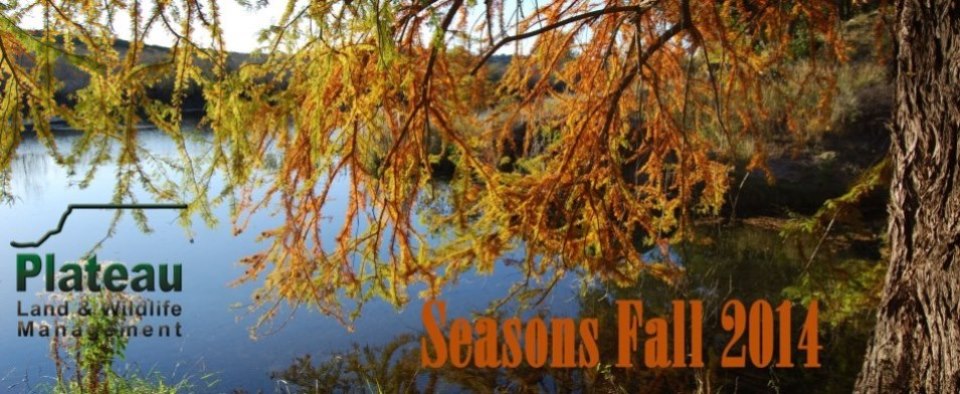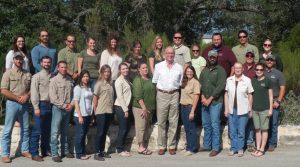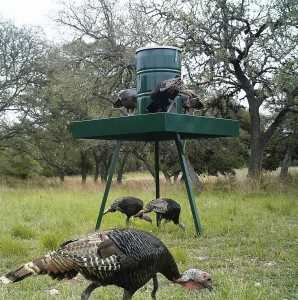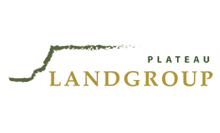Seasons – Fall 2014

From the Plateau Land & Wildlife Management Team,
It hardly seems possible, but another summer has left us and a beautiful Texas fall is now upon us. We had a pretty mild summer this year in comparison to last, and fortunately we have had more rainfall as of late which has improved drought conditions in parts of the state. With the arrival of fall, we all know that deer and quail season, crisp fall weather, changing leaves, and yes, even the holiday season, are right around the corner.
Fall also brings a rejuvenated excitement for life and an eagerness to reconnect with the land. This spirit is reflected in this issue of Seasons, in which we highlight several opportunities to improve and enjoy your land while also knocking out a few compliance activities before the end of 2014. Check out our Wildlife Management Fall Activities Checklist for guidance on which activities to focus on this season, learn about some common myths currently out there regarding the kissing bug, and find out more about the benefits of land use planning.
Here at Plateau we are also gearing up for fall by providing our clients, friends, and colleagues plenty of educational opportunities to expand your knowledge of Wildlife Management Tax Valuation (WMV). Review the list of seminar opportunities and find one for you to attend in a city near you.
We hope this issue of Seasons will help jump-start your celebration of fall, and if there’s any way that Plateau can help you protect, enhance, or better enjoy your land during this special season, just give us a call. We’ll be here when you need us.
 Until next season and Seasons,
Until next season and Seasons,
The Plateau Team
Table of Contents
Announcing : Plateau Seminars and Webinars this Fall
The Benefits of Plateau Land Use Plans
Kissing Bugs: How Worried Should You Be?
Fall Wildlife Management Activities Checklist
The Advantages of 1033 Tax Exchanges
Introducing Plateau Land Group
Rural Relationships — Domestic and Livestock use of Surface Water
Announcing: Plateau Seminars and Webinars this Fall
Wildlife Management Seminars
Every fall, Plateau Account Managers travel around the great state of Texas to educate folks about the many benefits of Wildlife Management Tax Valuation (WMV). These seminars are free and open to anyone interested in learning more about WMV. During each seminar, Plateau Account Managers, will cover:
- An overview of Wildlife Management Tax Valuation (“Wildlife Exemption”)
- The 7 wildlife management activity categories
- Traditional Ag vs. Wildlife…is it right for you?
- State & county requirements
- Concrete answers to concerns that plague many landowners
- How Plateau can help
Though some of you may already be under a WMV, these seminars will also benefit you, and anyone who owns rural land in Texas, including those who are currently in Ag.
To learn more about dates, times and locations of these seminars, visit our web page.
Back to TopBack to Top
The Benefits of Plateau Land Use Plans
By Craig Bowen, Account Manager for Plateau Land & Wildlife Management and Managing Partner for Plateau Land Group
It is often said the whole is greater than the sum of its parts. Plateau subscribes to this belief in the way our business is managed, and it is also true for land management. Often, the management techniques used on rural land seem relatively easy to implement or even unimportant, but when combined can reap major results on the ecology of a property.
Plateau Land & Wildlife Management has many products and consulting services which, used independently, are very helpful in their intended situations. Wildlife management tax plans, water resource consultations, brush management plans, home and road citing, wildlife surveys, and many more of these products are purchased every day to meet the needs of landowners. Sometimes, however, a client requires a special type of product, a product that goes beyond prescribing one remedy for a single issue, and addresses many issues simultaneously. Enter the “Plateau Land Use Plan.”
Land Use Plans are a vision. What do you want from the property? What are your goals? Is the property mainly an investment? Is it a residential purchase? Are you trying to build a legacy to leave for your children or grandchildren? Plateau consultants are more than just that, we are also good listeners, and we want to get to know you and the property so all your questions can be addressed in a unique way no other consulting firm can match.
Land Use Plans are exclusive. Not in the “lifestyles of the rich and famous” kind of way, but in the way that not every landowner or property is a good candidate. We use the “3 ‘Rs’ of Human Use” to identify an appropriate prospect – Recreation, Residential, and Revenue. If the your are interested in at least one of these components while at the same time desiring to be a good steward, a Plateau Land Use Plan may be the answer.
Keep in mind, Plateau Land Use Plans are an investment. They require a larger cash outlay than a tax plan or a site visit, but for the right person and property, there is tremendous value in this type of preparation and planning. We have seen countless mistakes made by landowners which have taken large sums of money to remedy. Clearing too much brush, building a lake in the wrong location, facing a home the wrong direction on that perfect hilltop, sloping roads improperly so they are constantly eroding, and stocking too many animals are just a handful of things that can go wrong without proper planning. We have also seen a relatively small investment upfront head these issues off at the pass to create something truly special for the discerning landowner.
So what does a Plateau Land Use Plan look like? A good example of the prime candidate might be a recently-acquired property over 50 acres, where the landowner is interested in converting the Ag Valuation status to Wildlife Valuation, citing and creating quality road infrastructure without causing erosion, choosing optimum homesite locations using quality consultants and sophisticated mapping technology, repairing and improving an existing water feature to be a recreational destination, and creating a wildlife-friendly brush management plan to clean up the property and increase recreational value. Plateau independently addresses all of these planning facets for landowners, and in a Plateau Land Use Plan, we can take all of these components together, discount them because we are more efficient handling these items all together than we are as a single unit, and create a plan to address all these items at once. Our biology and marketing teams then pair up to create a handsome document that you would be pleased and proud to share with friends, family, and business contacts.
Plateau is good at so many facets of land management and consulting services. But we excel at creating long-term strategies for maximizing the recreational, residential, and revenue potential on fine Texas land. Plateau Land Use Plans are a value-add service not every client needs, but for the right client, it may be all they need to be a successful land steward looking to maximize the recreational, residential and investment potential of their property.
Back to TopBack to Top
Fact or Fiction: Busting the Myths of Texas Wildlife
Kissing Bugs: How Worried Should You Be? by Andrea Julian, Plateau Land & Wildlife Management Biologist
Over the past few months we have been hearing a lot about the dangers of ‘kissing bugs’ in Texas. Warnings have been issued as to the potential danger that these insects pose to our health and safety due to the parasite they are known to host. You may be wondering just how worried you should really be about these pesky insects. However, before you panic let’s consider the facts about these insects and see if we can separate myth from reality.
There are seven species of kissing bugs, also commonly called cone-nosed bugs or chinches, that can be found in Texas. All species of kissing bugs are haematophagous, meaning they feed on vertebrate blood, similar to mosquitoes. They have earned the name of ‘kissing bug’ due to the fact that they feed at night on uncovered regions of their hosts body. Most victims are ‘kissed’ by these bugs on their face, especially round the mouth region because this area is uncovered during sleep.
Bites from kissing bugs can be problematic for two reasons. One, all species are potential vectors of a nasty little protozoan called Trypanosoma cruzi, which can cause an infection known as Chagas disease. Chagas is potentially dangerous because it can cause brain inflammation. Secondly, the salivary antigens released by the bug to keep blood from clotting while feeding has the potential to cause an allergic reaction on the skin of the host. Victims may awake to find the area around the bite site inflamed, itchy and sore. Some reactions are so severe that they require hospitalization.
So kissing bugs do have the potential to cause harm to their hosts but the actual risk of you or your family being harmed is, in actuality, fairly low. First of all, not everyone who is bitten by a kissing bug will show a reaction. Most people are not allergic to the salivary antigens. Those that are typically develop the allergy over time, so you would have to be bitten repeatedly to elicit a strong allergic reaction. Secondly, it is not a certainty that a given kissing bug will be carrying the Chagas protozoan at the time it bites you. If it is, it will have to defecate on your exposed skin (OK, that is gross, I know) in order for the protozoan to enter your body. Even if that does happen, there is only a 30% chance that you will develop any symptoms at all, and only a very small chance that it will be a severe reaction requiring treatment.
In addition, humans are not even preferred host of the kissing bug. When kissing bugs begin their lives as nymphs, they live in and around the burrows of armadillos and middens of rodents. It is only during the late summer and early fall that the mature bugs disperse and seek out new rodent host populations. It is during this time that they may find themselves sneaking into human habitations, enchanted by the lure of artificial lights and the waft of fresh carbon dioxide. However, it is more likely that they will encounter another type of host – such as a dog, cat, possum or raccoon – before they make it into a human house.
Unless you live in a grass hut, it is actually quite simple to keep kissing bugs out of your home. Make sure your door and window seals are secure and crack free. Keep windows and doors closed at night. Since kissing bugs tend to live in woodpiles, make sure that these are kept far away from your home (this is also important for reducing wildfire vulnerability). If you are out camping use a mosquito net at night and keep your tent well secured. Insecticides containing synthetic pyrethroids, such as permethrin, are also effective at deterring these pesky critters. If, however, you are unlucky enough to be kissed by one of these bugs and do suffer an allergic reaction, it is important to seek medical attention right away. Likewise, while the odds of infection are low and cases of Chagas are often symptom-free and go away on their own, if you develop a fever, rash, swollen eyelids or swelling of the infection site, body aches, or fatigue following a bite from a kissing bug, you should see your doctor. Chagas is easily treated in the rare cases of infection.
Back to TopBack to Top
Fall Wildlife Management Activities Checklist
By Kameron Bain, Business Development Manager for Plateau Land & Wildlife Management
 Fall is here, school is back in session, and our everyday lives are getting back to normal. That’s why it’s a great time of year to complete your wildlife management activities. With the end of the year quickly approaching, you’ll want to review your wildlife management plan to make sure you are meeting all your requirements, and properly documenting your activities. If you find that you have fallen behind, there are still plenty of activity options to choose from. Here are some qualified activities that are perfect for completing this fall:
Fall is here, school is back in session, and our everyday lives are getting back to normal. That’s why it’s a great time of year to complete your wildlife management activities. With the end of the year quickly approaching, you’ll want to review your wildlife management plan to make sure you are meeting all your requirements, and properly documenting your activities. If you find that you have fallen behind, there are still plenty of activity options to choose from. Here are some qualified activities that are perfect for completing this fall:
- Wintering and Resident Bird Survey– Start November 15
- Wildlife Management Activities Check-up
- Remote Camera Mammal Survey
- Imported Red Fire Ant Control
- Brush Management
- Re-seeding Wildflowers and Native Plants (El Niño should make this a great fall for seeding)
- Strip Mowing and Discing – Start November 1st
- Chemical Control of Huisache and Prickly pear
- Cut-stump Herbicide Treatments
- Tree and Shrub Planting – Start late Fall/Winter
- Brush Pile Construction
- Products Installs- Feeders, Water Tables, and Shelter
Back to TopBack to Top
The Advantages of 1033 Tax Exchanges
By Braun & Gresham Attorney, Patrick Reznik
When a property is condemned, it is important for a landowner to understand the tax consequences of the compensation they receive. Landowners can defer paying taxes for compensation received from condemning authorities under IRS section 1033. Monies received through an eminent domain or condemnation proceeding have unique qualities, and landowners should consider taking advantage of an IRS section 1033 exchange.
While similar to a 1031 exchange in some ways, a 1033 exchange does not require a Qualified Intermediary and is not subject to the same strict time restrictions. In a 1033 exchange, the landowner can use the monies received to buy “like-kind” real property. This can defer the payment of taxes.
Braun & Gresham, PLLC helps Texas landowners threatened by condemnation or eminent domain to receive the best compensation and easement terms possible. Rather than simply paying the taxes for the year in which payment was received, the landowner should get the appropriate tax advice and consider deferring paying taxes on the compensation through an IRS section 1033 exchange.
Back to TopBack to Top
Introducing Plateau Land Group
By Ryan Colleen Swartz, Marketing Coordinator
 For many years, Plateau Land & Wildlife Management and Braun & Gresham, PLLC. have worked tirelessly to serve the very specialized needs of the Texas landowner. And now, we are pleased to announce the addition of a real estate company, Plateau Land Group, L.P.,to our family of companies.
For many years, Plateau Land & Wildlife Management and Braun & Gresham, PLLC. have worked tirelessly to serve the very specialized needs of the Texas landowner. And now, we are pleased to announce the addition of a real estate company, Plateau Land Group, L.P.,to our family of companies.
Plateau Land Group’s work is very similar to the mission of both Plateau Land & Wildlife Management and Braun & Gresham, PLLC. Their aim is to provide the most complete set of services for the buyers and sellers of rural land, while educating both parties on how land can be a profitable investment, an enjoyable part of life, and the cornerstone of a family legacy.
Rural land has always been the passion of our family of companies , and we are constantly looking for ways in which to enhance our business and bring new and exciting products and services to the owners of rural land. At Braun & Gresham, we provide legal counsel in all aspects of rural land, Plateau Land & Wildlife Management, LLC. offers wildlife management plans and management services, as well as land use and property tax consulting, and now Plateau Land Group adds to the family of companies with real estate brokerage services.
We recognize there is a need for real estate professionals who are knowledgeable about the unique ecology and management of high-value rural properties. Plateau Land Group will guide rural property buyers, sellers, and landowners into making sound decisions while meeting their real estate and land management needs. We will also educate our clients about land ecology and the real estate transaction process, while helping them to protect their greatest assets & legacy, their land.
Please visit, www.plateaulandgroup.com, to learn more about Plateau Land Group. and how they may be able to help you, your family, your friends, and your clients realize their real estate goals.
Back to TopBack to Top
Rural Relationships — Domestic and Livestock use of Surface Water
By Braun & Gresham Attorney, Margaret Menicucci
With limited water resources in times of drought, many landowners are concerned about Domestic and Livestock use (“D&L Use”). Though a common practice on rural land, not all landowners understand their rights and obligations in relationship to other users of their river or stream. A landowner who has water that runs adjacent to their property or even through it, will likely have a dam on the property that creates a reservoir to hold water. This right to dam and use the water, in limited quantities, does not require a state permit; the State views the water use as a riparian right and provides a permitting exemption for D&L use. But there are some general rules to keep in mind:
- Each landowner with land along the stream or river has equal rights in the normal flow of the body of water.
- D&L use has quantity limits and the use must be reasonable with respect to the rights of others.
- Water obtained for D&L use must be used on the land that is adjacent to the river or stream.
- Landowners cannot put a dam on navigable waters of the State using the exemption (a permit is required).
Using these general rules as a guideline, every landowner should ask:what is a reasonable use with respect to the rights of others and what protection does a landowner have when they are concerned about a neighbor’s dam or D&L use?
The “reasonable use” concept has been interpreted to mean that the owner of a reservoir for D&L use must be able to return some water to the stream if it is needed by other D&L users (for example during a drought). If water is not made available from a D&L reservoir, the downstream user could turn to the Texas Commission on Environmental Quality (“TCEQ”) or the local court for enforcement.
The D&L use exemption is extremely valuable to landowners. If you have questions about the water rights on your property, we can help you understand and protect this valuable resource on your land.
Back to TopBack to Top







Sorry, the comment form is closed at this time.